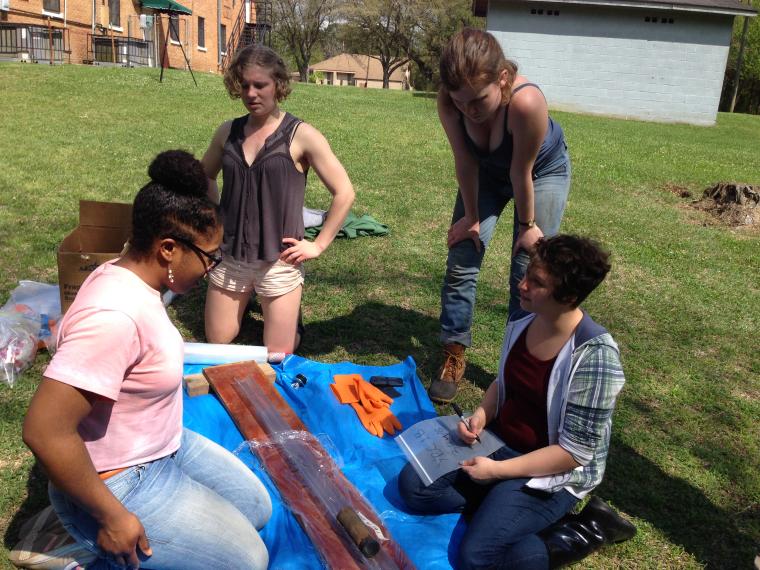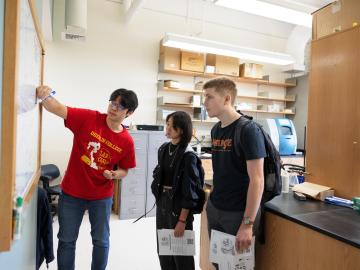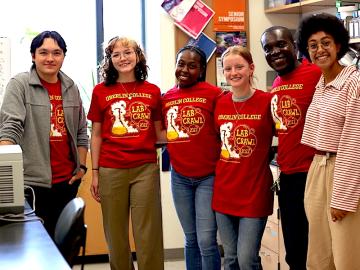Environmental Justice in a Tar Sands Battleground
April 20, 2015
Amanda Nagy

A tenet of the environmental justice movement is that the poor and people of color are more likely to live in America’s most polluted neighborhoods. Advocates assert that poor communities are unfairly targeted to host facilities with negative environmental effects, such as landfills, refineries, and highly polluting factories.
This inequity can be seen in communities along the Gulf Coast—a key battleground for the tar sands oil industry. A diverse group of students, led by Janet Fiskio, assistant professor of environmental studies and comparative American studies, formed an alliance with the residents of Africatown, Alabama, during a spring break research trip. At the invitation of community activists and the Mobile Environmental Justice Action Coalition (MEJAC), the Oberlin group collected soil samples and helped conduct a community health survey.
Located on the outskirts of Mobile, Alabama, Africatown has been targeted as the site of a Canadian tar-sands storage facility and pipeline. The tanks store diluted bitumen, the fossil fuel used to make liquid fuel and other products from Alberta.
Fiskio says the situation in Africatown is an example of environmental racism, and it’s not a recent problem. The town has been burdened by a series of polluting industries since the 1940s, when paper mills established operations for its close proximity to the Mobile River and the Gulf of Mexico. The story of the town’s origins reveals a more complex picture of the community, which holds a significant yet overlooked place in American history.
In 1860, more than 50 years after the United States passed legislation prohibiting the importation of slaves, two wealthy brothers from Mobile made a bet that they could import a shipload of African slaves without getting caught. They commissioned a ship that sailed to Ghana, West Africa. More than 100 Africans were captured and sold into bondage. Remarkably, it is told that all of the passengers survived the voyage.
To evade the authorities waiting in Mobile, the ship’s captain loaded the Africans on a riverboat and sent them ashore. They were hidden, and some were eventually sold, but many more escaped. More than 30 of the original captives made their way back downriver to the outskirts of Mobile, where they were left on their own to survive. Following the end of the Civil War and emancipation, they were joined by some of their fellow captives. They established a settlement that became known as Africatown.
Today, Africatown is the site of 11 different industries and sprawling tank farms that hold millions of gallons of toxic tar sand oil that arrive by rail. Fiskio says residents are deeply concerned about the health effects from pollution, mainly from dioxin, which is a byproduct of the paper manufacturing. The group from Oberlin handed the samples over to the community to send to a lab.
Oberlin is possibly the first outside group to help with environmental testing in Africatown. Fiskio points out that the Oberlin group was invited, and it’s clear that they were welcomed by the community. They arrived on a Saturday evening, and on Sunday morning they attended the local church services, where they were introduced to residents.
Aldrumesisa Baker, a senior geology major and environmental studies minor, was Fiskio’s research assistant for the project. She says Fiskio’s classes drew her to environmental studies because she’s interested in how race, class, gender, and political stances are inherently tied to climate issues.
“As a first-generation black student, I can see that places like where I’m from never get a voice in the scope of any current environmental movements,” says Baker, who grew up in Dallas, Texas. “From my understanding, Africatown has not received nearly as much recognition as it should have, even just from an African American historical sense. Environmental racism has surely played a large role in why industries have been allowed to concentrate their manufacturing and processing labors in such an historical district.”
Baker says she believes Oberlin’s presence in Africatown will help local activists gain recognition. “Gathering resources that can be allocated to the community, conducting soil samples, and using our extended network of well-connected individuals and groups are all ways in which we can aid the justice for Africatown movement. Given the distance between Africatown and Oberlin, current students can help by standing against big oil and fighting for related issues that are closer in proximity.”
Second-year student Anthony Moaton says the collaboration between Oberlin and Africatown is mutually beneficial. “I know that part of why we are doing this work is for the improvement of quality of life. However, creating relationships also allows for the development of more perspectives on differences in culture, worldview, and lived experiences,” says Moaton, a theater and religion major from Oak Park, Illinois.
In addition to the research trip, several students studied the historical contexts of Africatown in a private reading led by Tania Boster, director of student leadership programs at the Bonner Center for Service and Learning. They studied the National Register of Historic Places documentation (the status was awarded to Africatown in 2012) in the hope that the area’s profound historical significance might help block further industrial development. They also contacted historian Sylviane Diouf, who authored a monograph on Africatown, to inform her of the struggles the community is facing and request her involvement in the effort to preserve Africatown’s heritage.
Tags:
You may also like…
Oberlin Expands Impact Investment Platform to Help Improve World’s Troubled Regions
August 20, 2024
Measures follow recent steps to increase student participation in socially conscious investment decisions.
Friday Afternoon with Lab Crawl
October 30, 2023
This year’s Lab Crawl drew what may be the largest crowd in the event’s illustrious history, with some 500 students and dozens of faculty taking part. Missed out on the excitement? It looked something like this.
Lab Crawl: It’s Not Just for Scientists
October 24, 2023
Oct. 27 open house highlights research across the sciences—and just about everywhere else.


